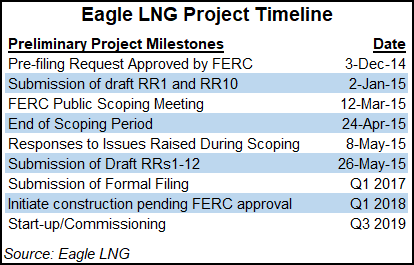Regulatory | Infrastructure | LNG | NGI All News Access | NGI The Weekly Gas Market Report
FERC Staff Advances Eagle LNG’s Florida Project with Positive DEIS
FERC staff has issued a positive draft environmental impact statement (DEIS) for the Jacksonville, FL, project, which would include siting, construction and operation of a liquefied natural gas (LNG) terminal and export facility on the north bank of the St. John’s River in Duval County.

Eagle LNG Partners Jacksonville LLC received approval from the Department of Energy last year to export up to 1 million metric tons/year (mmty) from the proposed facility [CP17-41]. It would include three LNG trains, each with a nominal capacity of 0.33 mmty and one LNG storage tank with a net capacity of 45,000 cubic meters.
“We determined that construction and operation of the project would result in some limited adverse environmental impacts, but impacts would not be significant with the implementation of Eagle LNG’s proposed and our recommended mitigation measures,” Federal Energy Regulatory Commission staff wrote in the 613-page DEIS.
FERC is accepting comments on the DEIS through Jan. 7.
The DEIS is the latest in a flurry of activity by staff since FERC issued environmental schedules two months ago for a dozen pending LNG terminal projects, including the Jacksonville Project, and signed a memorandum of understanding with the Pipeline and Hazardous Materials Safety Administration to coordinate the siting and safety review of FERC-jurisdictional LNG facilities.
In addition to the Jacksonville Project, FERC has in recent weeks issued DEIS for the Gulf LNG Liquefaction Project planned for Jackson County, MS [CP15-521], the Plaquemines LNG and Gator Express Pipeline project 30 miles south of New Orleans [CP17-67], the Port Arthur, TX Liquefaction Project [CP17-20]; the Driftwood LNG project near Lake Charles, LA [CP17-117 and CP17-118]; Texas LNG Brownsville LLC‘s proposal for an LNG export terminal at the Port of Brownsville in South Texas [CP16-116]; and NextDecade Corp.’s Rio Grande LNG project at the Port of Brownsville [CP16-454].
© 2024 Natural Gas Intelligence. All rights reserved.
ISSN © 1532-1231 | ISSN © 2577-9877 | ISSN © 1532-1266 |
